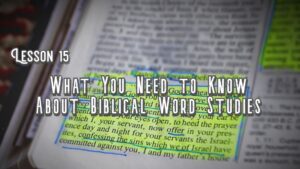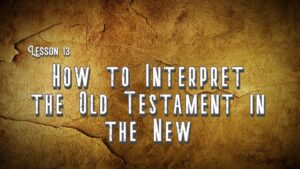The previous two lessons in this series have focused on the inspiration and authority of the Bible. A person cannot expect to understand the Bible correctly without first coming to grips with these two foundational principles. The Bible contains the very words of God in ink, and every word from alpha to omega is authoritative to the life of each intellectual organism. Now, which Bible translation should you use in order to understand correctly God’s self-revelation?
Choosing a good Bible translation is do-or-die to your personal Bible study. This is made grossly obvious if you pick up and read The Word on the Street translation. Of course, The Word on the Street is not really even a translation upon investigation. And while this satirical version is recognized as a joke, other translations of the Bible are equally lacking in their relaying of the original Hebrew, Aramaic, and Greek languages used by the Biblical prophets. For example, The Message is the next step down from the The Word on the Street. The Message is so far from a translation of the Bible, this work is nothing more than a commentary that passes for a Bible. Near the end of this lesson, there will be a table scale of Bible translations in order to highlight which modern translations are more word for word and which are more or less commentaries like The Message.
There are two phrases you should be familiar with: formal equivalent and dynamic equivalent. These phrases describe the two overarching categories of Bible translation methods. Formal equivalent translation is a fancy name for translating early Bible manuscripts word-for-word. One example of a word-for-word translation would be an interlinear Bible, where the Greek text is spelled out word-for-word, and underneath each Greek word is the English correspondent. However, because sentence structure and grammar do not flow over fluidly into the English language, this provides for a very choppy, difficult reading, in its most raw form that is. With some modifications to word order for the sake of readability, there are some English translations like the American Standard Version, which are considered by Biblical scholars the world round to be the most literal Bible translation on the market (outside of interlinear translation). Dynamic equivalent translation is another fancy name for translating early Bible manuscripts thought-for-thought. Instead of providing an English word that renders the original Greek text as literally as possible, this method of translation provides a thought-for-thought equivalent. This latter method of translation provides more room for interpretation by the translator himself, so that when the average reader gets hold of the translation (i.e. New Living Translation) he is getting a scholar’s commentary on the original manuscripts, more or less. The most gross example of such a translation would be The Message. A translation that rides the fence between word-for-word and thought-for-thought translation is the New International Version. James Smith relays the modern debate on the NIV very succinctly when he says,
“The NIV has been criticized for crossing the line at times from translation into commentary,” (61)
Several criteria (accuracy, appropriateness, naturalness, and form) are considered by Bible translation committees in order to produce a reading in the modern language that is simultaneously literal and readable (Comfort 233). If the translation is so literal and choppy that no one can read it, the process has failed. Then again, if the translators seek to make the modern version so readable that the English Bible loses the original meaning intended by the Holy Spirit, the process has likewise failed. Raymond Elliott summarizes this tender balance as follows,
“Is a Bible translation the inspired Word of God? Yes-to the extent that the translation relays to the reader what God directed the authors to write,” (Ibid. 259).
Because no translation is absolutely perfect, there is sometimes a need to consult Greek & Hebrew dictionaries in your Bible study. These will be covered in Lesson 15.
Finally, which translation should you use when studying the Bible? The simple answer is this: use a Bible translation that is as literal as possible, yet one that you can read easily. My personal favorite is the New King James Version for this reason. If I were to read another translation, I might choose the English Standard Version or the New American Standard Bible. Figure 1 is a chart relaying modern English translations of the Bible with the most literal (word-for-word) translations from left, to the more free (thought-for-thought) translations on the right. The only mistake on this chart is the placement of the Amplified Bible, which provides commentary interspersed with its translation, often leaving no indication where the commentary starts and where it ends.
(Figure 1)
I hope you enjoyed this study. The thoughts contained here are a small needle-in-the-haystack of content that spans the discussion of Bible translation. Buy one of the books below and read it for more scholarly information on the subject. Your decision on this matter will shape your understanding of the Holy Bible.
Homework Questions
1. There are two foundational principles that must be accepted before you can understand the Bible.
The Bible is _______________________.
The Bible is _______________________.
2. True or False:
All Bible translations are pretty much the same.
3. Match:
- Formal Equivalent ____ Thought for Thought
- Dynamic Equivalent ____ Word for Word
4. Why did you choose the Bible translation you currently read from? Is it a formal or dynamic equivalent translation? (Hint: use Figure 1 to find your translation and help in answering the question.)
Helpful Resources
Choosing a Bible by Leland Ryken
The Word of God in English by Leland Ryken
Introduction to Biblical Studies by James Smith
The Origin of the Bible by Philip Comfort
apologeticspress.org

![[Tags] Bible-Translation-2 Lesson 5- How to Choose a Bible Translation](https://fiveminutebiblestudy.com/wp-content/uploads/2017/07/Bible-Translation-2.jpg)


